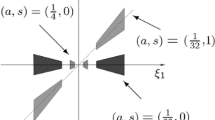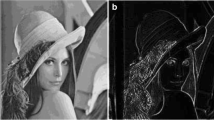Abstract
In this paper, non-sub-sampled shearlet transform (NSST) multi-scale analysis is combined with phase stretch transform (PST) to nonlinearly enhance images. The components of different scales after NSST multi-scale decomposition are processed by nonlinear models with different thresholds, and the noise is well suppressed while enhancing the detail features. The thresholds of the enhanced model are determined by the local standard deviation of PST feature map. Experiments on Matlab platform show that the proposed algorithm has improved image distortion, cleared details, and enhanced image contrast.
Access provided by Autonomous University of Puebla. Download conference paper PDF
Similar content being viewed by others
Keywords
1 Introduction
Image enhancement is a crucial pre-treatment step for many image processing applications. Image enhancement algorithms can be roughly grouped into two kinds [1]: space domain image enhancement and frequency domain image enhancement. Space domain image enhancement algorithm is mainly based on grayscale transformation, histogram processing, mean filtering, and other methods. Frequency domain image enhancement is also called transform domain image enhancement. Nowadays, the transform domain image enhancement algorithm has gradually become a research hotspot with the continuous development of multi-scale analysis tools [2,3,4,5,6]. Common multi-scale analysis tools for image enhancement include wavelet transform, contourlet transform, shearlet transform, and so on.
Image phase information plays a crucial role in the procedure of human perception of images. Phase information can reflect the space information of images and has a strong ability to interpret images [7,8,9].
From the above analysis, it is supposed that if we can combine the accuracy of multi-scale analysis with the stability of phase analysis in the process of image enhancement, we will get a more ideal enhancement effect.
2 Design of the Algorithm
2.1 NSST Multi-scale Analysis
Non-sub-sampled shearlet transform (NSST) is a multi-scale and multi-directional analysis tool. It is an optimal approximation, which is a “true” sparse representation of the image in all directions and at various scales. In addition, NSST does not perform down-sampling when performing multi-scale decomposition of an image. It combines a non-down-sampling tower transform with a non-sub-sampled directional filter bank and transforms. The size of the directional sub-bands of each scale is the same as that of the original image. The transform has shift-invariance and can overcome the pseudo-Gibbs phenomenon when the image is reconstructed.
2.2 Feature Extraction with PST
PST is a new image processing method proposed by Asghari and Jalali. It is said that PST has superior performance in feature extraction, especially edge extraction. It can even be applied to detect features in low-contrast visually impaired images [10]. The PST processing can be divided into several steps: Firstly, smooth the image with a low pass filter to reduce noise. Secondly, apply the PST kernel which has a nonlinear frequency dependent transfer function to the image. The output of the transform is the phase in space domain. The applied phase is frequency dependent with the original image, which is higher amount of phase applied to higher frequency features of the image. Finally, find image sharp transitions by thresholding the phase and apply binary morphological operations, so as to enhanced the features and clean the transformed image.
2.3 Nonlinear Enhancement Model
The enhancement function selected in this paper is presented by A. F. Laine in 1996. After that, many scholars applied this function to image enhancement processing and achieved good results. The enhancement function is shown in formula 1.
where \( a = \frac{1}{{{\text{sigm}}(c(1 - b)) - {\text{sigm}}( - c(1 + b))}} \), \( {\text{sigm}} \) is defined as \( {\text{sigm}}(x) = \frac{1}{{1 + {\text{e}}^{ - x} }} \).
In this function, there are two parameters of b and c, where b is used to control the enhancement range, and its value is usually between 0 and 1, while c is used to control the enhancement strength, and it usually uses the fixed value between 20 and 50. However, our algorithm does not preset fixed values for b and c. Instead, we set two thresholds of the function to determine the shape of the function curve, and then obtain the values of the b, c parameters.
2.4 Algorithm Flow and Steps
First, the NSST transform is applied to decompose the original image. After that, the NSST coefficients of different scales and directions can be obtained. Since image detail information often exists in high-frequency coefficients, we choose high-scale coefficients for processing, while low-frequency coefficients remain unchanged.
Considering that PST algorithm has obvious advantage in extracting features of image, the proposed method extracts the details of the original image by PST and uses its output as the image feature map. This feature map can clearly distinguish the region where the detail information is concentrated, so it can be used as the reference of image enhancement. Figure 1 is the feature map of the Lena image processed by PST.
After PST, we calculate the local standard deviation of each pixel in the feature map. The local standard deviation reflects the contrast change of the local area in an image. Therefore, the pixels with larger local standard deviation in feature map will be rich in the detail texture around it, so they should be enhanced, while the region with the smaller value of the local standard deviation can be mildly enhanced or preserved.
The enhancement of the NSST high-scale coefficients depends on the output of the nonlinear enhancement model. In order to facilitate the calculation, the values of the input need to be normalized. The nonlinear enhancement function of Fig. 1 contains two thresholds. One threshold is the first intersection of the enhancement function and the line of y = x. It is the threshold that characterizes the feature coefficients from noise coefficients. We call it T1. If the abscissa value of a certain point on the function curve is less than T1, then the value of its ordinate will be reduced nonlinearly, that is suppression (applicable to noise information); while if the abscissa value of a certain point on the function curve is greater than T1, the value of its ordinate will be nonlinearly stretched, that is enhanced (applicable to detail information). The other threshold is first intersection of the enhancement function and the line of y = 1. It is the threshold that determines the extent of enhancement. We call it T2, if the abscissa of a certain point on the enhancement function curve is larger than T2, it is considered as strong edge, so this part will be enhanced greatly.
As shown in Fig. 2, the abscissa value in the graph is set to be the local standard deviation of the corresponding pixels in the PST feature map. We choose the k1 times of the minimum value in the local standard deviation as T1 (k1 is a positive integer greater than 1) and k2 times of the maximum as T2 (k2 is a positive integer greater than 1). After that, if we bring the pixel’s local standard deviation in the PST feature map into the enhancement function, we can get the enhancement ratio at the pixel in the enhancement curve. It is the ratio of the ordinate value to the abscissa value. Finally, the NSCT coefficients of the N-scale can be multiplied with the enhancement ratio. After the processed NSCT coefficients are inversely transformed, the enhanced image is formed.
3 Experiments and Simulation
3.1 The Experiment Settings
We carried out experiments on two images, they were Lena and Barbara. As a contrast, wavelet nonlinear enhancement, NSCT nonlinear enhancement, the NSST nonlinear enhancement proposed in the literature [5], and the algorithm proposed in this paper enhanced four images, respectively. All experiments were carried out on Matlab R2016b platform.
3.2 Subjective and Objective Evaluation
The enhancement results are shown in Figs. 3 and 4, among which (a) is the original image, (b) is acquired using wavelet nonlinear enhancement, the NSCT nonlinear enhancement result is presented in (c), (d) is the enhancement result with the method proposed by literature [5], and (e) is the image enhanced by our algorithm. Through subjective evaluation, our algorithm has significant effect on image contrast stretching and edge enhancement. The enhanced images have no pseudo-Gibbs phenomenon, and the details are clear without obvious distortion.
Generally, it is difficult for human beings to perceive the mild differences among the enhancement results of various algorithms. Hence, the paper adopts two widely used objective evaluation parameters, Edge Preserved Index (EPI) and Contrast Improvement Index (CII), to evaluate the image enhancement effects. The greater values of EPI and CII indicate the better quality of the image. It can be seen from Table 1 that the effects of our algorithm are more ideal than the other algorithms.
4 Conclusion
This paper describes an approach for accomplishing a nonlinear image enhancement algorithm that combines NSST and PST and takes the advantages of multi-scale analysis and image phase analysis to perform nonlinear enhancement of images. The algorithm can enhance image details and edge features without amplifying noise. Experiments on Matlab platform show that the algorithm is better than other algorithms in the experiments in terms of accurate edge preservation and adequate contrast enhancement.
References
Lee S-Y, Kim D, Kim C. Ramp distribution-based image enhancement techniques for infrared images. IEEE Sig Process Lett. 2018;25(7):931–5.
Kim K, Kim S, Kim KS. Effective image enhancement techniques for fog-affected indoor and outdoor images. IET Image Proc. 2018;12(4):465–71.
Dong L, Bing Y, Mei Y, et al. Image enhancement based on the nonsubsampled contourlet transform and adaptive threshold. Acta Electronica Sin. 2008;36(5):527–30.
Huang L, Zhao W, Wang J, et al. Combination of contrast limited adaptive histogram equalisation and discrete wavelet transform for image enhancement. Image Process Lett. 2015;9(10):908–15.
Tong Y, Chen J. Nonlinear adaptive image enhancement in wireless sensor networks based on non-sub-sampled shearlet transform. EURASIP J Wirel Commun Network. 2017;2017(1):46.
Tong Y, Chen J. Compressive sensing image fusion in heterogeneous sensor networks based on shearlet and wavelet transform. EURASIP J Wirel Commun Network. 2017;2017(1):52.
Dong Y, Long T, Jiao W, et al. A novel image registration method based on phase correlation using low-rank matrix factorization with mixture of Gaussian. IEEE Trans Geosci Remote Sens. 2017;56(1):446–60.
Fan J, Wu Y, Wang F, et al. SAR image registration using phase congruency and nonlinear diffusion-based SIFT. IEEE Geosci Remote Sens Lett. 2014;12(3):562–6.
Cakir S, Kahraman DC, Cetin-Atalay R, Cetin AE. Contrast enhancement of microscopy images using image phase information. IEEE Access. 2018;6:3839–50.
Suthar M, Asghari H, Jalali B. Feature enhancement in visually impaired images. IEEE Access. 2017;6:1407–15.
Acknowledgements
This work was supported by National Natural Science Foundation of China (Grant No: 61701344), Tianjin Edge Technology and Applied Basic Research Project (14JCYBJC15800) in China, Tianjin Normal University Application Development Foundation (52XK1601), Tianjin Normal University Doctoral Foundation (52XB1603, 52XB1713), and Tianjin Higher Education Creative Team Funds Program in China.
Author information
Authors and Affiliations
Corresponding author
Editor information
Editors and Affiliations
Rights and permissions
Copyright information
© 2020 Springer Nature Singapore Pte Ltd.
About this paper
Cite this paper
Tong, Y., Li, K., Chen, J., Liu, R. (2020). Nonlinear Image Enhancement Based on Non-sub-sampled Shearlet Transform and Phase Stretch Transform. In: Liang, Q., Liu, X., Na, Z., Wang, W., Mu, J., Zhang, B. (eds) Communications, Signal Processing, and Systems. CSPS 2018. Lecture Notes in Electrical Engineering, vol 516. Springer, Singapore. https://doi.org/10.1007/978-981-13-6504-1_18
Download citation
DOI: https://doi.org/10.1007/978-981-13-6504-1_18
Published:
Publisher Name: Springer, Singapore
Print ISBN: 978-981-13-6503-4
Online ISBN: 978-981-13-6504-1
eBook Packages: EngineeringEngineering (R0)








